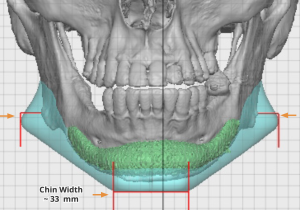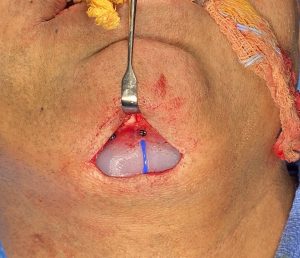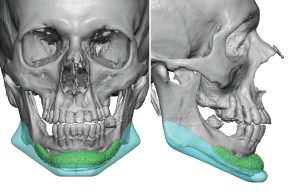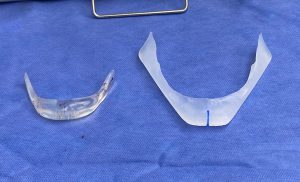Background: While all standard chin implants are designed to provide varying amounts of horizontal projection they have a round shape to them. The one exception is the chin implant whose name describes what it intended to do…the square style chin implant. It is fair to say that this is primarily used in men who request a specific square shape to their chin augmentation.
While perhaps effective for some patients there is a fundamental flaw in its design. Its square shape comes from added width to the sides of the implant. While this adds more material for augmentation a square chin shape does not come from making it wider. A wide chin implant merely makes it wider. Rather it comes from making it more square at the corners and as well as making it more narrow as the horizontal projection brings it forward. These more exaggerated implant designs help push out the thicker soft tissue chin pad so this shape change can be seen.These are observations from seeing thousands of 3D CT scans of natural chins as well as looking at the effects of many custom chin and jawline implant designs. This is knowledge that was not available decades ago before 3D CT scans and custom implants were commonly done.
Regardless of the chin implant placed some patients will come to recognize that a more complete jaw augmentation effect is desired. This can occur even when the chin augmentation result is good. But particularly so if the chin augmentation result is less than desired. While the indwelling chin implant will need to be removed it does provide invaluable information as to how to improve the chin area the next time.
Case Study: This male had a prior history of a square style chin implant. By his 3D CT scan it was a style 1 square implant with 7mms projection. It was placed higher up on the bone that ideal with its upwardly curved wings close to the mental foramen.


Case Highlights:
1) Standard square style chin implants primarily rely on rounded width for its effect which is not particularly effective.
2) In making a more square chin, either as a custom chin or around jawline implant, the key design element is angular chin corners and a more narrow chin width.
3) Standard chin implants, even with good results, often serve as a springboard into a more complete jawline augmentation.
Dr. Barry Eppley
World-Renowned Plastic Surgeon




